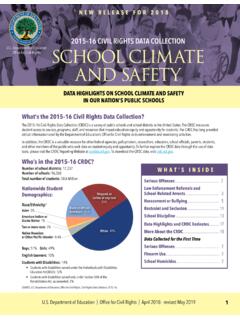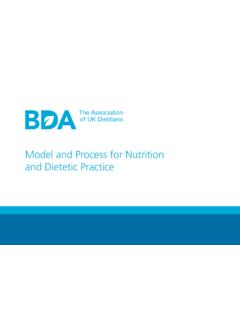Transcription of Health Characteristics of Adults Years of Age and Over ...
1 Number 370 + April 11, 2006 Health Characteristics of Adults 55 Years of Age and Over: United States, 2000 2003 by Charlotte A. Schoenborn, ; Jackline L. Vickerie, ; and Eve Powell-Griner, , Division of Health Interview Statistics Abstract Objective This report highlights the Health Characteristics of four age groups of older Adults 55 64 Years , 65 74 Years , 75 84 Years , and 85 Years and over providing estimates by sex, race and Hispanic origin, poverty status, Health insurance status, and marital status. Methods The estimates in this report were derived from the 2000 2003 National Health Interview Surveys Family and Sample Adult questionnaires. Estimates are based on interviews with 39,990 sample Adults aged 55 Years and over.
2 Results Overall, prevalence rates for fair or poor Health , chronic Health conditions (with the exception of diabetes), sensory impairments, and difficulties with physical and social activities increased with advancing age, doubling or even tripling between the age groups 55 64 and 85 Years and over. About one in five Adults aged 55 64 Years were in fair or poor Health , rising to about one-third of Adults aged 85 Years and over. Men and women were about equally likely to be in fair or poor Health across the age groups studied, but women were more likely to have difficulty in physical or social activities. Sociodemographic variations in Health were noted across the age groups studied, with the most consistent and striking results found for poverty status and Health insurance coverage.
3 Poor and near poor Adults and those with public Health insurance were, by far, the most disadvantaged groups of older Adults in terms of Health status, Health care utilization, and Health behaviors. Conclusions Health status, Health care utilization, and Health -promoting behaviors among Adults aged 55 and over vary considerably by age and other sociodemographic Characteristics . Identifying these variations can help government and private agencies pinpoint areas of greatest need and greatest opportunity for extending Years of healthy life among the Nation s seniors. Keywords: elderly c older Adults c Health status c chronic conditions c difficulties with activities c Health care utilization c adult immunizations c Health behaviors c National Health Interview Survey Introduction Older Adults represent an ever-increasing proportion of the population.
4 In 1900, Adults aged 65 Years and over constituted of the population. By 2000, this percentage had tripled to , and the number of Adults in this age group grew from million to 35 million (1). The near elderly population, comprised of those aged 55 64 Years , accounted for percent of the population ( million) in 2000 (2). Together, the near elderly and the elderly represent a significant and growing portion of the population. According to the Census Bureau, by 2020 the population aged 55 64 is projected to be million, and those 65 Years and over is projected to be million (2). There have been substantial improvements in life expectancy during the past century. In 1900 1902, life expectancy at birth in the United States was Years (3).
5 Life expectancy was Years for Adults reaching age 55 Years and for those reaching age 65 Years at that time, life expectancy was Years (3). In 2002, life expectancy at birth was Years , at age 55 it was Years , and at age 65 Years , it was Years (3). Such statistics support DEPARTMENT OF Health AND HUMAN SERVICES Centers for Disease Control and Prevention National Center for Health Statistics 2 Advance data No. 370 + April 11, 2006 expanding the public Health focus on promoting quality of life at the older ages. Assessing the distribution of Health impairments and Health risks of the near elderly as well as the elderly is an important step in furthering efforts to enhance Health and well-being of older Adults in the United States.
6 The Federal government, as well as public Health researchers, has been expanding activities to monitor and improve the Health of older Adults . The Department of Health and Human Services Web site highlights many agencies and organizations that are involved in aging-related activities (4). Among the Federal agencies and offices engaged in such activities are the Administration on Aging (5), the Agency for Healthcare Research and Quality (AHRQ) (6), the Centers for Disease Control and Prevention (CDC) (7), the Center for Medicare and Medicaid Services (8), and the National Institutes of Health s National Institute on Aging (9). CDC s National Center for Health Statistics (NCHS) has an ongoing aging initiative and maintains a data warehouse on Trends in Health and Aging (10).
7 A report on key indicators of well-being for older Americans is published periodically by the Federal Interagency Forum on Aging Statistics (11), and a series entitled Aging Trends, initiated in 2001 by NCHS, publishes information on aging-related topics (12 16). In Health , United States, 2005, the 29th report to the President and the Congress on the Health status of the Nation, a special section was devoted to the Health of Adults aged 55 64 Years (17). The expanding public Health focus on older Adults is further evidenced by the increasing volume of literature on the Health and well-being of the Nation s older population (18 27). This report, which highlights Health Characteristics of Adults aged 55 Years and over in the United States, is the first of a series of periodic summary reports on older Adults using data from the National Health Interview Survey (NHIS).
8 NHIS, one of the major data collection systems of NCHS, is an annual survey of a nationally representative sample of the civilian noninstitutionalized household population. This report complements and broadens data from the NHIS presented in the periodic publication Aging Trends. It presents national prevalence estimates for selected Health indicators for Adults aged 55 64 Years and 65 Years and over with detailed information for Adults aged 65 74 Years , 75 84 Years , and 85 Years and over. The report provides a snapshot of the current Health status of Adults aged 55 Years and over and adds to the existing body of literature by providing additional benchmarks for charting progress in improving the Health and well-being of older Americans in the 21st Century.
9 data from the 2000 2003 National Health Interview Surveys were used to derive estimates for each of these four age groups by sex, race and Hispanic origin, poverty status, Health insurance coverage, and marital status (28 31). The Health indicators in this report include Health status, selected Health conditions, difficulties with physical and social activities, use of Health services, and key Health -related behaviors that are particularly relevant to the older population. This report highlights some of the most prominent age and subgroup differences in these Health indicators. Methods data source The statistics shown in this report are based on data for sample adult respondents to the 2000 2003 National Health Interview Surveys (NHIS) (28 31).
10 Information on Health and demographic Characteristics was collected in the family and sample adult components of the annual core questionnaires. As noted earlier, NHIS is a survey of a nationally representative sample of the civilian non-institutionalized household population. Basic Health and demographic information is collected in the family component for all members of the family. Adults present at the time of the interview are asked to respond for themselves. Proxy responses are accepted for the family component for Adults not present at the time of the interview and those who are physically or mentally incapable of responding for themselves. Additional information is collected from one randomly selected adult aged 18 Years and over (that is, the sample adult ) per family.














